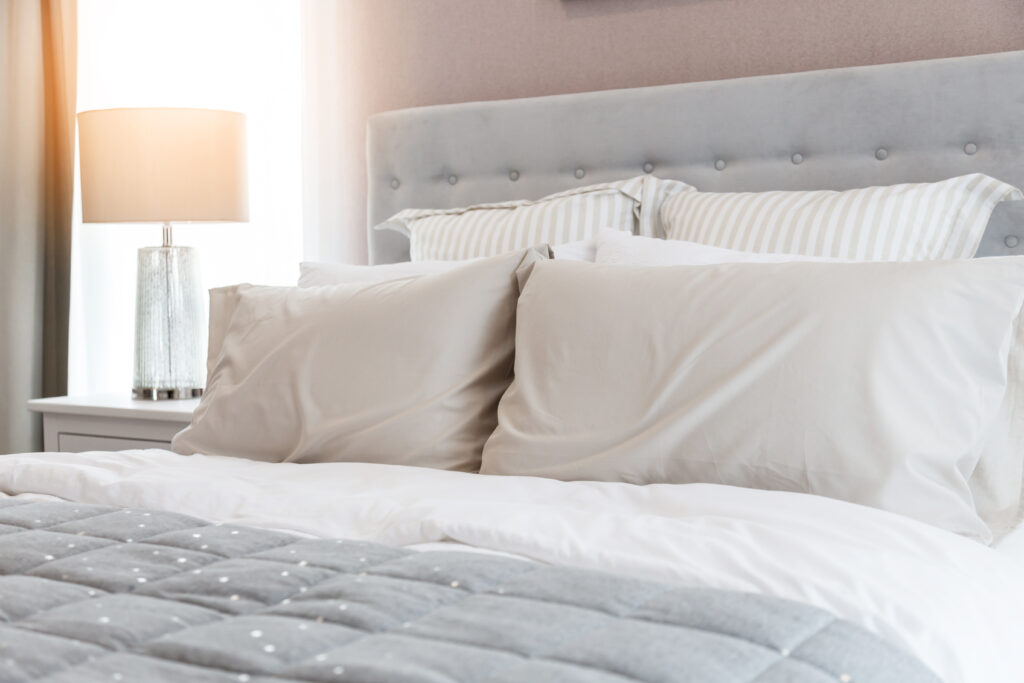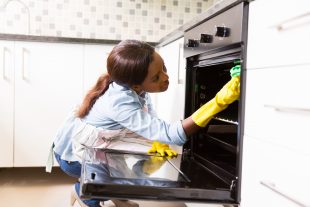 Get How-To's
Get How-To's
How to Prepare for a Move
How often should you wash your sheets? Find out.
Read tips, tricks, and how-to’s on our Fabric of Life blog.
Garment Guides

Pillows are one of the most familiar pieces of furniture which can be found on sofas and beds. Germs, bacteria, dirt, sweat and drool, saliva and mold, or even mildew can rack up inside the pillow over time as a result of daily use, as well as pet hair and dander – if you have a pet that sleeps in the bed with you. The accumulation of bacteria and smells will result in unpleasant odors from the pillows and will also result in the break – down of their support. These bacteria will also infest on people, as well as increase their chances of having an allergic reaction, particularly those who are allergic.
Every homemaker should be aware that humans spend one-third of their lifetimes sleeping with their heads on their pillows. To keep pillows clean and clear of germs and debris, every caregiver should make a conscious initiative to clean and wash them every few months, depending on how frequently they breathe. Just before washing or cleaning pillows, special care must be taken to prevent damage to the fill and materials in the pillows. Also, if pillows are not handled properly, the material can clump or shrink. This article will teach you what you need to know before washing your pillows, as well as why you should wash them, how to keep them clean, how to fluff them to perfection, and when to replace them.
To begin with, if you have never cleaned your pillows before, or perhaps, it’s been long months since you have done so, then those pillows of yours are almost due for a cleaning. As there are some possible signs, you will get to feel or see when your pillows are unclean or need to be washed. Signs like unpleasant smells emanating from your pillows, physical stains and ailments like dead skin cells, and even acne-causing germs. However, below are some other probable indicators that your pillows need to be washed;
However, suppose you still encounter any of the issues listed above after washing or cleaning your pillows. What you need is not cleaning but replacing your pillows, especially if you have had them for a long time and use them every day.
Washing your pillow incorrectly can damage the materials, prevent the pillows from adequately supporting your head and neck, and increase the risk of developing chronic pains. Pillows can generally be washed easily, either in the washing machine on a gentle setting or by hand, with a careful reading of the cleaning instructions. Some filling varieties may state that they should be dry cleaned or hand-washed only, and disregarding these cleaning instructions can cause damage to both the pillow and the filling.
Cleaning the bed sheets is just as important as cleaning the pillows, and the first point to keep in mind is that, unlike bed sheets, you don’t have to wash comforters, pillows, and other down items every week. However, you should clean your entire bedding collection to eliminate harmful bacteria and unpleasant odors at least once a season.
It is essential you keep your pillows clean, but then if not correctly done, you will end up causing more damage to them. So how do you have it done accurately? Below are the following measures that are crucial to keeping your pillows clean in order to reduce the number of times you need to wash your pillows.
Washing the pillows and pillowcases is indeed an excellent way to keep your sleeping area clean. Less commonly used Pillows, such as those found in the guest room, do not need to be washed as frequently. Discoloration or the smell of a slightly sour or musty odor are the first signs that your pillows require immediate attention or care. Even a regularly washed pillowcase is porous, and it will not safeguard your pillow from dust mites, fungus, bacteria, sweat, and body oils over time, which is why you should probably need to wash the pillow. Washing pillows that are no longer fluffy or as comfortable as they were when new could help refresh and revive them.
Pillows that are used frequently can accumulate dust mites, fungus, bacteria, sweat, body oil, and allergens. Pillowcases can help combat or reduce this debris formation, and hence pillows should also be clean. To prevent the growth of debris, mold, and bacteria, they should be cleaned at least twice a year, every four to six months. Pillows used less frequently, like those in a guest room or storage room, don’t have to be washed as often and should be aired out when not in use.
Hurling your pillows in the washing machine and dryer is a quick and easy method to revitalize your bedding staples. However, to achieve this at home, you will need a front-loading, non-agitating washer to avoid damaging your pillows. And in case you don’t have one at home, you can consider moving your pillows to a laundromat or the nearest dry cleaning company, where an enormous commercial washing is conducted. As most pillows come in different textures, materials, and designs which means there will be differences in what is required to have them washed. Most pillows filled with cotton, feather, down, and fiberfill, are advised not to be soaked in water as they can only be dry cleaned or hand-washed. However, for some other types, this might not be the same. Such as pillows made of feathers, solid foam, and fiberfill are not to be treated in the same way. Therefore, it is essential that you thoroughly read each pillow’s cleaning instructions before commencing with the cleaning because sometimes it may require a lot of care, and going against this advice may cause damage. The following are some fundamental approaches and instructions for effectively washing various kinds of pillows:
Most pillows can be washed on a low heat and gentle cycle using a washing machine. Carefully remove pillowcases and coverings such as pillow protectors and liners before washing, and use the warmest water temperature and gentle cycle. Ensure to adhere to the instructions on the pillow’s care tag. Only use a tablespoon of detergent to prevent excessive soapy water and detergent buildup inside the pillow. The washer should not be overloaded, and the load should be balanced by washing two pillows in a single spin.
Change the settings on your machine to utilize hot water and go through a subsequent rinse cycle. Use it if your machine has a “bulky/large” cycle setting.
Transfer pillows to the drying chamber once the wash is completed, using two dryer balls in separate clean, white socks. Throw these dryer balls in the dryer with your pillows to fluff them up and help them dry faster. When drying synthetic filling pillows, it is always important to use low heat, so choose a low-heat setting and start your dryer.
When your dryer has finished drying, take the pillows out and feel them for dampness. Check the moisture content of the pillows by smelling them. If your pillows aren’t completely dry, repeat the drying process and recheck them. Otherwise, your pillows are neat and tidy.
Most feather and down-filled pillows can be machine washed and dried. Although powder detergent can leave a residue, it is best to use a small amount of liquid detergent. Depending on the space available in the washer, perhaps there is enough space; you can wash two down pillows at once.
Use cold water and a mild detergent. Run an extra rinse cycle to remove excess soap and protect the feathers from heat, use the no-heat or air-fluff dryer setting or go to the dry cleaners. If you’re uncertain about washing feather and down pillows at home, most dry cleaners offer a specialized pillow cleaning service.
Unfortunately, machine-washing is not an option for cleaning pillows with a more structured fill. Hand-washing is preferred for memory foam or latex pillows. Use only a small amount of detergent with lukewarm water since they can’t be washed or dried in the machine. Fill a bucket halfway with lukewarm water and a tablespoon of detergent; the water should accommodate the pillow completely. Completely remove the pillowcase and gently soak in the memory foam. Allow the solution to circulate by massaging the pillow. The pillow should be raised. Squeeze out the soapy water and repeat two or three times more. When handling memory foam, be cautious because it is easily damaged. Rinse with clean water, squeezing gently until the water runs clear. Allow the pillow to air dry flat, preferably in the sun.
Even with the finest care, a pillow will still need to be changed sometimes, and no matter how thoroughly you clean your pillows, experts recommend replacing them every two years to ensure that your pillows are clean and free of filth, which will offer you with sufficient support. Replacing your pillows is a fantastic act of cleanliness since not changing your pillows can cause allergic reactions, rashes, and neck strain, as well as making it difficult to find a comfortable sleeping posture, as discussed earlier in this post. More like your mattresses, Pillows should be replaced when they begin to droop or develop lumps. However, how do you know if your pillows are to be replaced? Here you have your answers. Below are the safest and most precise methods of determining whether to replace or buy yourself some new pillows and let go of the old ones.
There are numerous types of pillows available for various occasions, but most of us are completely ignorant that they can be washed. Pillows accumulate dust and debris, sweat, and oil particles over time, which, if left unchecked, can turn your cushions yellow and make them less comfortable to use. To extend their lifespan and practice proper hygiene, wash them once a month as directed on the care label, either by hand or in a washing machine.
We think you may like
 Get How-To's
Get How-To's
How to Prepare for a Move
 Get Garment Guides
Get Garment Guides
How To Transition Your Summer Wardrobe Into Fall
 Get Tips and Tricks
Get Tips and Tricks
Ways to Save Time for Spring Cleaning